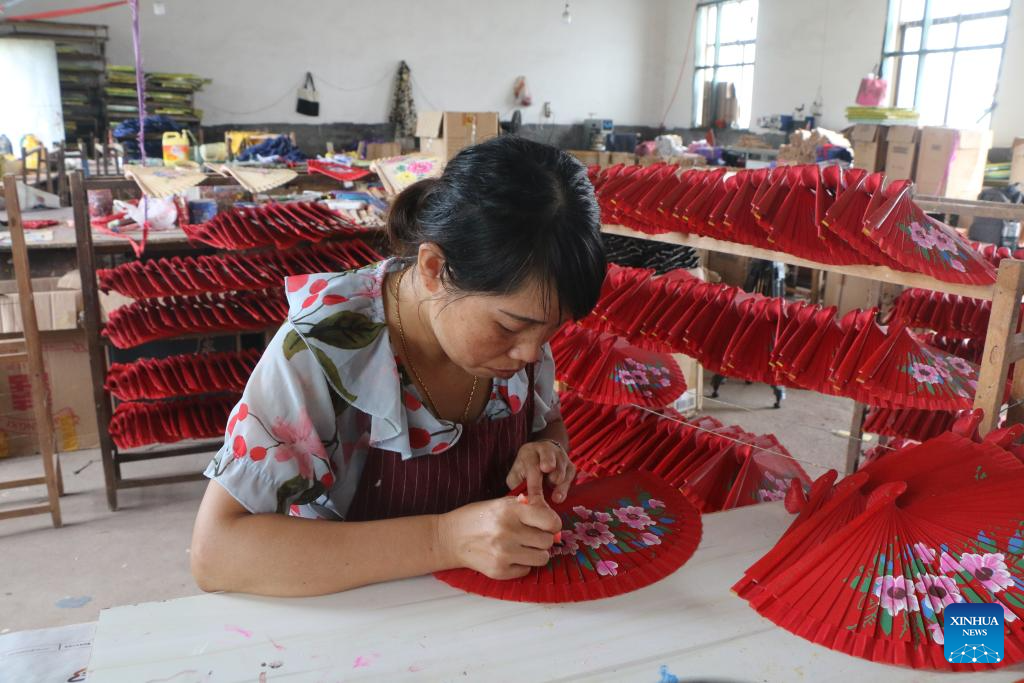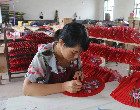Culture News
Across China: Handicraft wooden fans from east China spark vitality overseas
2023-10-01 21:20:46

NANCHANG, Sept. 29 (Xinhua) -- In a wooden fan workshop in Jiangxi Province, east China, Yu Xiuying is busier than usual. As she paints, delicate flowers bloom into life across the fan.
"Now I decorate at least 120 fans a day," said the artist, who has 14 years of fan painting under her belt. As the market recovers, orders for handicraft wooden fans have increased, she added.
The fans Yu painted in Ganzhu Township in Guangchang County will be exported to Spain. The obscure small town boasts a flourishing handicraft fan industry, with an annual output of over 70 million fans and an output value of over 300 million yuan (about 41.78 million U.S. dollars). More than 5,000 of the town's 28,000 population work in the industry.
The town's fan-fame dates to the early 1980s. When selling cedarwood oil in Suzhou City in Jiangsu, Liu Bingzhao from Ganzhu noticed that from the streets to alleys, from parks to scenic spots, locals always carried a sandalwood fan with them.
Moreover, fans could be spotted in nearby coastal areas. Liu and his peers acted; they visited a local factory to learn to process fans.
In 1984, they returned to open businesses. "We brought technicians and equipment back to Ganzhu Township, and raised nearly 20,000 yuan to set up a processing plant," said Liu.
As the plan took off, more specialists were trained and the products gained popularity in cities including Suzhou, Beijing, and Guangzhou. In 2003, Liu and others registered the Jiangxi Shenglian Fan Development Company Limited, of which the annual output value at its peak exceeded 30 million yuan.
The high-quality and exquisite fans have attracted European buyers, with Spain as a hub.
"At the end of each year, Spanish merchants book orders for the coming year. The fans are exported to Spain through agents in Yiwu City (China's small-commodity hub), and then distributed all over Europe by Spanish merchants," Liu said, adding that Spanish wooden fans have become the main products of his enterprise, with an annual order volume of over 1 million fans.
The success fanned a craze in the town, and locals flocked to the industry. Today, there are more than 200 fan enterprises and mini-workshops.
"I don't have much space here, but I sell more than 400,000 Spanish wooden fans a year, with an annual output of over 2 million yuan," said Luo Shuiwen from Luojia Village in Ganzhu Township, who established a workshop in 2019. The over 100-square-meter space is equipped with all the essentials such as stamping and cutting machines, and fans flow smoothly along the production line consisting of more than 20 procedures.
The growing production scale has been boosted by the adoption of advanced technology. Wang Honglu, who also owns a fan company, said that he uses UV flatbed printers. "The four machines are capable of painting more than 4,000 wooden fans a day, which has greatly improved production efficiency and met the new demands of the Spanish market for mass production of standardized products."
In July, the construction of a fan industrial park in Ganzhu Township began to facilitate the industry to enlarge its scale, be more standardized, and establish its brands.
"The planned park covers an area of 110 mu (about 7.3 hectares) with an investment of 2 billion yuan, and the part under construction covers more than 30,000 square meters and is expected to be completed in July next year," said Jie Xiaomao, an official with Ganzhu Township.
After the park is completed, the government will take the lead in developing industrial norms, integrating scattered family workshops and enterprises, and establishing a complete industrial chain to optimize the industrial environment, said Jie.
Editor:Jiang Yiwei

 手机阅读分享话题
手机阅读分享话题